“What we want to do is put the bike counts into the context of… Were all trips down? We’re thinking that’s the story.”
— Roger Geller, PBOT bike coordinator
When Willamette Week reporter Beth Slovic broke the story about PBOT’s 2009 bike count numbers yesterday, we were shocked. Our surprise was two-fold: First, although we’d heard speculation that the counts would be down compared to 2008, it was still surprising to learn it had actually happened; and second, we had asked PBOT repeatedly for for the results of the counts (which have historically been released in November) but were told that no numbers would be released until January.
Slovic was called out by Joseph Rose of The Oregonian yesterday because a PBOT staffer told him the report didn’t exist. Today, Slovic produced a PDF of that preliminary report in order to prove she was not making it up. Much of that report includes information from 2008 (PBOT was using it as a template), but we’ve confirmed that the 2009 numbers presented are accurate.
PBOT spokesman Dan Anderson told us today that no report of the bike count (in either draft or final form) has been made public. He also confirmed that no public records request was filed for one. This leads us to believe that Slovic was likely tipped off to the report by someone inside PBOT.
Now, let’s move on to the numbers.
Here are the some of the key findings from the draft report made public by the Willamette Week today:
- Bike traffic on the 4 main bike-friendly downtown bridges (Hawthorne, Broadway, Steel, and Burnside) and at 100 non-bridge locations citywide have shown an annual decrease of 8% and 5% respectively.
- Compared to 2008 counts, overall bike use in Portland decreased 6%.
- Helmet use is down from 80% in 2008 to 77% in 2009 (women wear helmets 8% more often than men).
- The amount of female riders went down 1% in 2009 — from 32% to 31%. The decline in male ridership at the 100 non-bridge locations went down 4% in 2009.
Here’s a chart taken from the preliminary report that shows how non-bridge counts from various parts of the city compare with years past:
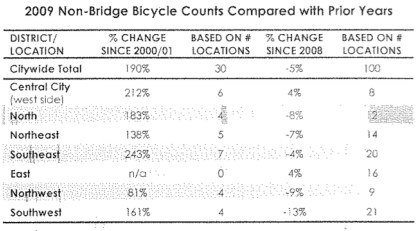
That chart illustrates that, taken as a long-term trend, bike traffic is still headed in a very positive direction — which is certainly something PBOT will hope becomes the focus of attention when the full report is released in early January.
If we take out the anomalously high numbers in 2008 and compare 2009 to 2007’s numbers, we see an increase that maintains the previous upward trends:
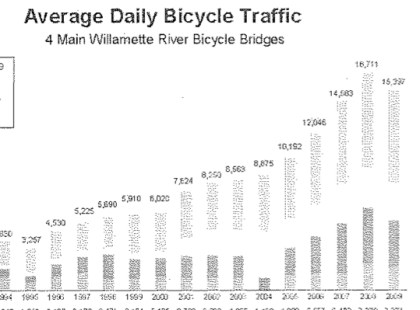
Now that we know the numbers are indeed down, the question is — why? Many people have offered theories, but we were curious if PBOT bike coordinator Roger Geller had any hunches of his own.
Besides the obvious reasons of the recession and the huge spike in gas prices last year, Geller offered two main theories. The first is that it’s likely trips for all travel modes were down in 2009. Geller says unfortunately they don’t have any motor vehicle count data but that PBOT staff are searching their databases for auto counts done as part of transportation projects in similar locations to where they counted bicycles. They’re also looking into fuel purchase data. “What we want to do is put the bike counts into the context. Were all trips down? We’re thinking that’s the story.”
Geller, as he already stated elsewhere, also feels that we could be reaching a “plateau with our current infrastructure.”
“We can’t expect continuing increases unless we really begin to make improvements to our infrastructure that approach world-class design standards. Part of it might just be that the pool of people that are going to ride on these types of facilities are limited. And we know they’re limited… and that’s what the Portland Bicycle Plan is all about.”
That perspective is likely to be repeated by Geller and other PBOT staffers when they testify in front of City Council on behalf of the Bicycle Plan on February 4th.
The plateau hypothesis is very interesting. If indeed it’s true, it could foretell a similar trend in other cities. After all, Portland is still the nation’s top big city for bike traffic and trends we see here are likely to occur elsewhere in years to come.
As for how this report was leaked to the media, Geller told us he has “no clue really” how it happened. Yesterday we wondered whether or not PBOT was trying to stall these numbers. That’s not the case according to spokesman Dan Anderson. He told us today that, “There was no strategy behind not releasing this thing. It was just a matter of staff time and prioritizing.” Geller echoed Anderson’s line, saying he still hasn’t really had a chance to delve deeply into the numbers.
While PBOT has certainly been putting a full-court press on the Bicycle Plan, it still seems to us like they were stalling a bit in getting these numbers out. The sharp rise in bike counts in recent years has become a pillar of Portland’s transportation story (with Geller being it’s main storyteller), and these numbers, regardless of what accounts for them, change that to some degree.
A small dip in bike traffic (especially one that seems to be mimicked across all other modes) is nothing to be ashamed of, and there’s no reason to keep us in the dark about it. We look forward to seeing the full report. Stay tuned.


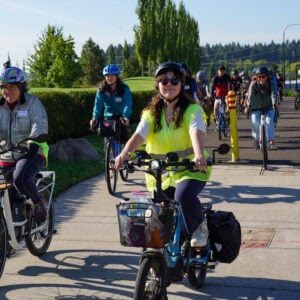
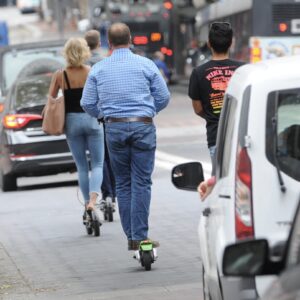
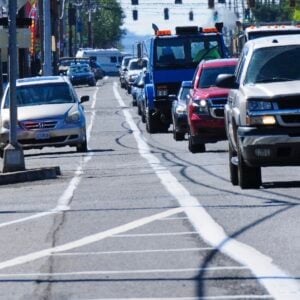

Thanks for reading.
BikePortland has served this community with independent community journalism since 2005. We rely on subscriptions from readers like you to survive. Your financial support is vital in keeping this valuable resource alive and well.
Please subscribe today to strengthen and expand our work.
Roger’s explanation makes sense to me: less jobs = fewer commute trips, regardless of mode. I’ll buy it.
It’s important to note that the bike counts are just counts, and don’t represent mode share. Bike traffic may have declined 5%, but if we find out later that motor vehicle traffic in 2009 declined by 6% or more, we would still show an increase in mode share. The sky is not falling on biking in Portland – it just fell on the economy.
I work from home now, so I no longer commute downtown 3-5 times a week like I used to at least in 2008. Instead I do 1-2 errand runs per week by bike during the day, and stay closer to my hood the rest of the time, sometimes choosing to walk to local amenities. I get out on my bike more in the evening for social events…
I suppose one could look at the weather during last year’s and this year’s counts too. With the numbers relatively close 6% could be a influenced by something like a string of hot days/rainy days.
Stupid green line.
I’m with Carye. My office is now on the eastside, not downtown. I still commute by bike, but counting only traffic that goes into the downtown area doesn’t tell the whole story.
Oilman Bush and Cheny are gone, and the continued fear of endless oil wars has vanished. Ride your bike, protest foreign oil’s chokehold on the economy. Too bad Bush isn’t still around as a symbol of big bad oil and it’s strangehold on American commuters.
i expect that a high percentage of people who used to commute but now work at home might comment…
ME NEXT!
whatever, id say this article more than balances the scale. though i also wonder about its numbers:
http://www.guardian.co.uk/lifeandstyle/2009/dec/15/cycling-bike-accidents-study
I would note that we also saw a slight drop in streetcar ridership compared to last year – something that has also only gone up in recent history.
My belief is that both declines can best be explained by the economy.
Like Carye @2 and Stacy @5, I’m still biking but no longer counted. I lost my job this year, but fortunately found another. I used to cross the Willamette river every day on the Broadway bridge to get to work, but now I cross the Columbia on the Interstate Bridge instead. Different river … not counted 🙁
I wonder why compiling this report would take so much staff time? haven’t they done this report for years now? it should be cut and paste/run some statistics from last year’s template.
having said that, I have never worked for the city of portland and may be overstating or misunderstanding their process.
but, man, this summer sure seemed to be bike busier than last.
saying that ‘a plateau has been reached’ with current infrastructure is a completely self-serving lie.
cyclists have been out ahead of the infrastructure curve for years now, and besides, cyclist-specific infrastructure is hardly necessary to ride your bike, when every road is a bike route and every lane is a bike lane.
Cyclists Allowed Full Lane ORS 814.430(2)(c)
Thanks to the economy, I now run 2 offices and only commute downtown by bike 3 days a week. When they end up dumping a third office on me, it will only be 2 days a week.
It seems a little premature to talk about a decline in biking when we don’t yet know the mode share.
2008 was a bumper year, no doubt. I had several coworkers ask me that summer for commuting tips when gas approached $4/gal. (One guy sold his Escalade.) Then they got laid off.
Anyway, we shouldn’t hang too much advocacy on the popularity of bicycles. Popularity comes and goes, remember the bike boom of the 70s/early 80s? Building infrastructure to serve existing need puts the cart before the horse: let’s talk about how infrastructure drives need, not the other way around.
Geller’s “plateau” theory, that’s interesting.
2008 was an anomaly, the trend line is climbing, no need to worry!
I still ascertain that sampling was different this year. Last year I remember being counted. This year there was no counter in that location (NE 41st/Davis). Doesn’t mean I’m not biking, though. I believe this change could possibly be in the “noise” of the sampling methodology, paired with the lower trends across all modes.
burr 11, you seem to be intentionally missing the point geller is trying to make. there are people who will not readily use a bike as daily transportation unless you provide segregated facilities. you or i (or even roger) may not need or want these things, but if you build them some number will come. there are people who might be persuaded to use the bicycle for transportation, but only if some substantial part of their route were segregated. i have met these people, and they have in fact begun to ride when the facilities were provided. they will not come out unless there are segregated facilities, but they will if there are. therefore, if you do nothing further, you have a plateau. this is an objectively truthful statement, and i say that as a person who has no problem taking the lane on sandy or whatever.
814.430(2) would not be necessary if 814.430(1), the far to right law, were repealed, and 814.430(2) does not help you at all where 814.420(1), the mandatory sidepath law, applies. bottom line, i don’t have a problem with facilities, but we have to repeal the mandatory sidepath and far to right laws.
I got to think that bike, car, truck (etc.) traffic goes up and down, but over time it all goes up. The thing that bugs me the most here is why “PBOT” withheld the information this year? Maybe because the results were a little “inconvenient” for Sam and others?
BURR; you’re preaching to the choir in here about taking a lane. but i know you know that this isn’t a reasonable thing to say to the sketched out novice cyclist interested in getting to work via bike. come on…
i’ve been laid off since may, but never biked to work via a bridge, and still bike daily.
“Obama” troll:
Can we get over the childish “Blame Bush” nonsense and not make this a political discussion?
I suspect the economy is the number one cause. It’s gonna be hard to compare transit ridership with other modes because a) huge service cuts were implemented in May; b) in 2008 steel bridge was closed for weeks which makes comparisons almost irrelevant and c) Green Line opened in September, along with more bus service cuts.
April was the last month before transit service changes and it showed only a one percent decline, but the economy got worse over the summer. In combination with serious service cuts, ridership was down 8 percentn in July. So it’s likely transit ridership declined about the same percentage or less if you take other factors into account, but impossible to know for sure.
One year does not a trend make.
I work from home now too, however I still ride the evening commute to meet my sweetheart down town and we ride from there to home in parkrose hood. So I guess nothing has changed. I still see the same bikers commuting as in past years. When you commute everyday you tend to notice the dedicated ones out there,and they you. Ive noticed an increase in driving trafic though, it just seems that there are more cars out there than in the past year. More the reason to ride to work. To ride down town it takes almost 40min. To drive it’s only ten minutes faster or the it takes the same time and that doesnt include finding parking and the time it takes to walk to work from parking. If you drive your in the negative (time,Money & health) compared to biking to work. My two cents…
If we take out the artificially high numbers in 2008 and compare 2009 to 2007’s
I’m not sure that artifical is the best word to use here. Perhaps aberrant?
Yeah. You’re right. I’ll take another look at that and consider a change. Thanks. — Jonathan
I scanned what others wrote and didn’t see what i would think is the most obvious reason: Gas Prices were significantly higher in 2008! especially in the spring, summer, fall.
Personally speaking, my enjoyment of riding a bike when commuting has been affected by a number of enthusiasts who seem to regard two wheels as a social movement, rather than simply a mode of transportation.
I haven’t driven a car in over ten years; depending on where I need to be in a day, I will either travel by bike or bus. Prior to 2008, I lived in Minneapolis; and for years – even when I owned a car – 90% of my commuting was by bike; year-round, snow and all.
Since moving to Portland, I find myself commuting less by bike, as there often seems to be no observed standard for bike traffic here. I’ve literally been forced out of lanes and cut off by people driving bikes far more than by those in automobiles. These days, when I commute by bike, I look for alternate paths with little or no other bike traffic. A number of near-miss experiences have illustrated that I need to be wary among groups of people on bicycles, who may exhibit any number of unpredictable driving patterns, thus posing a safety hazard.
Part of what accounts for the change in my own bicycling habits is that laws exist here but are often not enforced (in Mpls, a license was mandatory, for example) or are enforced arbitrarily; others are met with resistance as somehow assailing personal freedoms. I think this stems from a sentiment Ray Thomas expressed in an interview (Portland Monthly; 2007, I believe), that part of the bike traffic demographic consists of people who see themselves as rebels who feel they are above the law. That might work well for activities like zoobombing, but we’re talking about traffic here. There really can’t be separate rules of conduct for different modes of transportation. One of the big messages of Critical Mass back in Minneapolis was, “We ARE traffic.” That seems pretty simple in theory – why is so difficult in practice?
JakeIT,
Nobody “withheld” information. The staffers who work on the bike count report are the same people who have been quite busy working on the Portland Bike Plan.
Stockholm has segregated facilities ( which were a real pain in the ass to ride on when I was there, although to be fair, their cycle tracks aren’t as well designed or as wide as those of Copenhagen or Amsterdam) and it’s modal share is roughly the same as ours at 7 percent. The auto will remain a superior form of transport for most, regardless of infrastructural buildout – UNLESS policies are passed that punish driving, such as Denmark’s 200 percent tax on car sales or the higher gas tax and tolled freeways that you find all over Europe. Good luck finding popular support for any of these measures in the US. I suppose adding cycle tracks on every arterial will punish driving too by removing parking spaces or driving lanes. For some of us, however, our choice to bike does not make us want to associate ourselves with a sanctimonious agenda that desires to punish the majority – who are still motorists – for the sake of pseudo-green bs.
I’m not opposed to all bike infrastructure – some of it is rather helpful. However, I don’t delude myself into believing that it will make the vast majority of people I know want to bike. Most people I have met only would as a last resort. My transport preferences need not be everybody’s.
Jonathan,
While I don’t agree with the judge’s ruling could we use this as precedent to get the city to paint bike-lanes on all intersections? That would preclude this judge and others from using this weird exemption in the future. At the very least if the city didn’t want to spend money on more paint they could petition a clarification to this law to address the issue. In other words can we work within the system on a number of fronts to address this issue?
Cheers,
My money’s on Mr. Geller’s guess, that all trips were down in 2009. Stats **could** show a continued increase in percent of trips by bike. More juicy to me would be the (hoped for) percentage drop in car trips vs. other modes. Increasing bike use is good, but decreasing car use is more to the point, whether that use migrates over to transit, walking, ride sharing, or cycling.
Shetha (#15) – I assure you that there were counts at NE 41st/Davis — I did one, in the evening (4pm-6pm), in late July. Maybe you were on vacation that week. 🙂
I hear Tri-Met’s numbers aren’t down as much as bicycling. Is this true?
I really don’t want to come across as melodramatic here in any way, but I think this needs saying…
As a year-round bicyclist for six years here in Portland, I have been finding it increasingly upsetting to keep on biking. I have considered stopping my bike commute, and trading it in for the bus this coming year.
Why?
I have noticed that lately, it sometimes seems like a “war zone” out there on some of the bike boulevards. I wish I could think of another way to put it, but that’s the best description I can come up with. The bike boulevards I use to commute to work on my bicycle have, in the past year or two, shifted to unofficial motorist “rat runs”, and it feels really, really scary to be a cyclist out on some of them.
There are so many new people moving here to Portland from all over… California, Michigan, Ohio… you name it. Many of them moved here with their cars. And as the traffic on the major arterials gets worse and worse, people are looking for alternative “short-cut” roads to use as commute alternatives.
Ankeny St is a key example. It’s supposed to be a bike boulevard. Yet SO many motorists use it as a rat-run to get from the Burnside Bridge to SE 20th. Many more use it as a shortcut coming off SE 12th, to avoid the messy intersection at Sandy & Burnside. They are so discourteous and intimidating to the bicyclists who are supposed to have some sort of right-of-way on the street.
On Ankeny alone, I have had motorists tailgating me, revving their engines loudly, or screeching around me in a huff, and all because I have the audacity to be bicycling on a bike boulevard. Last year, somebody threw a glass bottle out of their car window at me, which made me too scared to bike for about a month afterwards.
At the same time, the Transportation Options division is out there, trying to get people out on bikes. But there is not much hope of getting “joe public” out on a bike, if these are the conditions they are going to have to bike in. There is no way in hell I would allow my six year old daughter to bike on Ankeny between MLK/Grand & 20th. It’s too dangerous. There’s too much traffic on it.
To any of the city planners reading this, I would really, really like to see diversion used as a tool for calming our bike boulevards. PLEASE. You are simply not going to get the “average” family, or lady, or new commuter, out there on a bike, if they continue to feel intimidated and harrassed by so many of the motorists that use these facilities as speedy, direct shortcuts, which is what they have become when the stop signs are flipped.
Thankyou for reading.
Ivy, nothing melodramatic about your comments at all. You are right on about what’s happened to Portland. They’ve got to be dreaming if they expect “families” to be out cycling in some parts of this city. The east part of Portland seems to have been completely ignored save for the I-205 bike path, but other than that forget it. As a cyclist you are treated like a freak out here. Ivy just don’t give up on biking! Don’t let “them” win. It really is the most wonderful to see and experience Portland.
If you look at the bridge crossing graph, 2008 is a blip on a general and significant upward trend. Ridership is up over 2007 and still way up over 2006. Factoring in gas prices and the economy, I’d say the bike riding trend is still on the increase.
When gas prices go back up, which they will, fair-weather bicyclists will be back. In the mean time I will continue to support getting my friends on bikes. There’s too much at stake not to.
I wonder if Portland’s high unemployment is starting to shake out some young adults who got around primarily on bikes? Seems like over the past few years there’s been a growth in the 20-something population. These are the folks who have been hardest hit by the recession.
“This leads us to believe that Slovic was likely tipped off to the report by someone inside PBOT.”
Oooo! an Unnamed Source! PBoT obviously needs some Nixonian Plumbers.
Another possibility: though I am not doubting the ability to count
2007 could have been slightly over actuals
2008 could have been slightly under actuals
Why? Depending upon when the counting occurred, you never know. Could have been warmer or colder which effects numbers. The economy, and many other factors could also play a part.
I was actually nervous about the NYC counts this year since the month of October had some extremely wet days, and I thought that might keep the numbers down. Thankfully it wasn’t the case.
There shouldn’t be any panic unless there is a two year trend. For now, look to next year!
Just my own personal anecdote here, but telecommuting has really taken hold with my own job. That’s reduced my 4 trips a week to just one at most.
And since the commute routine is gone, it’s just so much “easier” to jump into the car for that occasional visit. No more days to stage clothing at work, laptops, etc.
Well said, Ivy [#34].
We can create the most beautiful cycling infrastructure, but without ACTIVELY DETERRING AUTO USE, they will “plateau” in a hurry.
To be fair, PBOT seems to be looking at more diversions and other means of auto calming, in the newer bike boulevard plans.
Let’s not forget the car parking issue – why is so much of our VALUABLE STREET SPACE given over to the storage of auto’s? While it may have been an historical progression, it needs to be changed. Political will with something bigger than pea-sized blanketyblanks is required.
The fact that the width of the car-free streets of our beloved Sunday Parkways were literally halved by the presence of parked cars was hugely disappointing.
I really hope PBOT will prioritize the removal of car parking for the upcoming [5] Sunday Parkways.
I don’t agree with this count. Last spring, summer and fall commutes to me had many more bikes then the year before. The line up to get across the Hawthorne bridge were much longer. Ladd’s addition, Clinton Street had many more bikers then last year. The bike parking area at OHSU was in overload. I can’t believe the count is down.